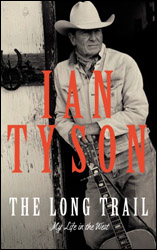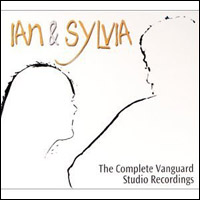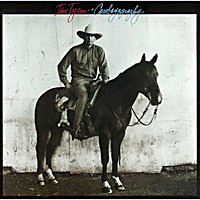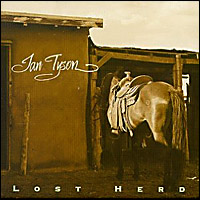|
Ian Tyson
|
|
Bronco busting was his passion
during his late teens and early twenties, until a rodeo accident in 1957 crushed his ankle. He then pursued musical interests, forming influential folk duo, Ian and Sylvia, and writing "Four Strong Winds" |

c 1961
|
|
|
|
|
| Ian Tyson was born September 25, 1933, and lived with his parents and older sister, Jean, at 2785 Dufferin Street. | ||||||||||||||||||||||||||||||
|
||||||||||||||||||||||||||||||
| His visits to Smugglers' Cove, on Ten Mile Point, with his father stirred his imagination. These childhood fantasies would one day become the inspiration for his song, "Smugglers' Cove." | ||||||||||||||||||||||||||||||
|
||||||||||||||||||||||||||||||
|
||||||||||||||||||||||||||||||
| His parents provided two very different influences on his life. His father was out-going and fun-loving, but his mother was a strict, no-nonsense Presbyterian who wouldn't tolerate frivolous things, like comic books, in the house. | ||||||||||||||||||||||||||||||
| Ian's childhood imagination was kindled by the cowboy stories in the Will James' books that his father gave him. Will James became his cowboy hero, and his stories and drawings of the West would become formative influences in Tyson's life. | ||||||||||||||||||||||||||||||
| His father kept two horses, Ginger and Steel, on a small farm in Cadboro Bay, where Ian and his father enjoyed galloping along the beach when not wandering through the Uplands. Thus began Ian's life-long love of horses. | ||||||||||||||||||||||||||||||
|
||||||||||||||||||||||||||||||
| The Tyson family moved to 1550 Wilmot Place in the early 1940s, and up the street to 1649 Wilmot Place in the mid 1940s. | ||||||||||||||||||||||||||||||
|
||||||||||||||||||||||||||||||
| In 1946, when Ian was 13, he was enrolled at Glenlyon, a private school for boys. He was active in rugby, boxing, shooting and drama. Ian graduated from Glenlyon in 1951. | ||||||||||||||||||||||||||||||
| After graduation he took a job with the Provincial Forest Service and worked on Vancouver Island. It's here that he first became interested in rodeo riding | ||||||||||||||||||||||||||||||
|
||||||||||||||||||||||||||||||
|
||||||||||||||||||||||||||||||
| While working for the forest service, Tyson decided to apply to the Vancouver School of Art. 6 | ||||||||||||||||||||||||||||||
|
||||||||||||||||||||||||||||||
|
In 1954 he was accepted into the four-year program at the Vancouver School of Art. During the summers he worked at Banff, Alberta, where he wasn't far from rodeos.
|
||||||||||||||||||||||||||||||
| In 1956, during his third year at art school, he discovered he could sing. | ||||||||||||||||||||||||||||||
|
||||||||||||||||||||||||||||||
| During that school year he made his singing debut at the Heidelberg Café in Vancouver, and played with a rockabilly band, "The Sensational Stripes." | ||||||||||||||||||||||||||||||
| After his third year at art school he was back working in Banff in the summer of 1957. On one fateful day, he took time off work to compete in the Dogpound Rodeo, just north of Calgary. | ||||||||||||||||||||||||||||||
| It's at this rodeo, at the age of 24, that his dream of becoming a rodeo cowboy came to an abrupt end when he shattered his ankle while competing in a riding event. | ||||||||||||||||||||||||||||||
| While convalescing in a Calgary hospital he taught himself guitar by learning to play Johnny Cash's "I Walk the Line," which was everpresent on the radio at that time. | ||||||||||||||||||||||||||||||
| Back in Vancouver (on crutches) in fall of 1957 for his fourth and final art school semester, Tyson graduated from the four-year program in spring of 1958. | ||||||||||||||||||||||||||||||
| After the door closed on his rodeo dreams, he realized two new doors had opened for him: art and music. | ||||||||||||||||||||||||||||||
| He experimented with jazz, blues and rockabilly before pursuing folk music. The songs of the Kingston Trio intrigued him, and the music of Odetta inspired him. | ||||||||||||||||||||||||||||||
| 1958 found Tyson in Toronto — working as a commercial artist by day and performing in coffee houses at night as a folksinger. | ||||||||||||||||||||||||||||||
| It's here he met singer, Sylvia Fricker, and began performing on stage together, though not yet as a duo. | ||||||||||||||||||||||||||||||
|
||||||||||||||||||||||||||||||
| In 1961, they worked together as Ian and Sylvia and moved to New York City to perform in Greenwich Village. It's here they hung out with Bob Dylan and met his manager, Albert Grossman, who also managed Peter, Paul and Mary. | ||||||||||||||||||||||||||||||
| Dylan played Tyson his new song, "Blowin' in the Wind," which inspired Tyson to write his first song, "Four Strong Winds." 9 | ||||||||||||||||||||||||||||||
| Grossman was impressed and secured a record contract for the Canadian duo with Vanguard Records. Their first album, Ian and Sylvia, was released in 1962. | ||||||||||||||||||||||||||||||
| "Four Strong Winds" was not included on their first album, although they sang it regularly at their live performances. Other acts, like The Brothers Four and Glenn Yarbrough heard the song and released their versions in 1963. | ||||||||||||||||||||||||||||||
| Ian and Sylvia released their version of "Four Strong Winds" in 1964, the same year they married. | ||||||||||||||||||||||||||||||
| Since then, over a hundred artists have recorded "Four Strong Winds," in a variety of genres. | ||||||||||||||||||||||||||||||
|
||||||||||||||||||||||||||||||
| The mass popularity of folk music in America came to an abrupt end with the British Invasion in the mid 1960s.10 Ian and Sylvia responded by forming their group, Great Speckled Bird — an early progenitor of country-rock. | ||||||||||||||||||||||||||||||
| In 1965, Ian bought a farm outside of Toronto but continued with his music, which included his own television show, The Ian Tyson Show, on CBC. | ||||||||||||||||||||||||||||||
| By 1975, Tyson called it quits. He divorced Sylvia, left his weekly television show and moved back to Alberta to work with horses. | ||||||||||||||||||||||||||||||
| Ian Dawson Tyson died December 29, 2022. | ||||||||||||||||||||||||||||||
|
* * * |
||||||||||||||||||||||||||||||
| Ian Tyson is the recipient of The Order of Canada and has been inducted into 5 industry Halls of Fame. He has garnered 3 Honorary Doctorates and received numerous citations and awards from every corner of the entertainment industry. | ||||||||||||||||||||||||||||||
| 1 Tyson, Ian. Ian Tyson — The Long Trail: My Life in the West. (Random House: 2010) 14 | ||||||||||||||||||||||||||||||
| 2 Ibid. 15. | ||||||||||||||||||||||||||||||
| 3 Ibid. 20. | ||||||||||||||||||||||||||||||
| 4 Ibid. 25.The Gothic mansion was the former Pemberton home, Wilmot House, the driveway to which became Wilmot Place. | ||||||||||||||||||||||||||||||
| 5 Ibid. 33. | ||||||||||||||||||||||||||||||
| 6 Tyson's natural drawing ability was tutored by renowned artist, Edward Goodall, who had moved into the former Tyson residence at 1550 Wilmot Place | ||||||||||||||||||||||||||||||
| 7 Ibid. 35–36. | ||||||||||||||||||||||||||||||
| 8 Ibid. 43. | ||||||||||||||||||||||||||||||
| 9 Folk singers traditionally searched ethnic sources for new material. Bob Dylan changed everything by writing his own original folk songs. | ||||||||||||||||||||||||||||||
| 10 February 9, 1964, to be exact —the day the Beatles made their first performance on the Ed Sullivan television show | ||||||||||||||||||||||||||||||
|
PHOTOGRAPHS
|
Do you have any photographs of Ian Tyson's
early years in Oak Bay?
If yes, please specify in the form below
|
ARTIFACTS / Books & Recordings
|
BOOKS
Click on book covers to read reviews
or to order online from amazon.com
|
IAN TYSON
The Long Trail: My Life in the West Random House 2010 |
IAN & SYLVIA
Four Strong Winds McClelland & Stewart 2011 |
RECORDINGS
Click on album covers to read reviews
or to order/download from amazon.com
|
IAN & SYLVIA
Greatest Hits Vanguard 2002 |
IAN & SYLVIA
The Complete Vanguard Studio Recordings Vanguard Records 2001 |
|
IAN TYSON
Cowboyography Vanguard Records 1994 |
IAN TYSON
Lost Herd Vanguard Records 1999 |
Do you have any artifacts related to Ian Tyson's
early years in Oak Bay?
MAGAZINE or NEWSPAPER ARTICLE, ETC
If yes, please specify in the form below
|
RECOLLECTIONS
|
Recollections may be abridged for length and/or clarity
| "We moved into 1550 Wilmot Place in the winter of 1945. I was three years old at the time but my memory of the street from 1945 through 1964 is very clear. . . . |
| One celebrity spent his early years on Wilmot Place — Ian Tyson, Canadian performer of authentic music from our western heritage. Ian lived with his parents and sister at the very end of the street. |
| Decades after they had moved, myself and another boy discovered a secret room under the front steps of his old home. There we found a candle sitting on top of an old butter box with a stack of very old comic books from the '30s and '40s. The room was named 'Ian’s Hiding Place No. 1' (We wondered where #2 was.)" |
| — Richard Goodall, OBHS class of 1960 |
Do you have any recollections of Ian Tyson's
early years in Oak Bay?
If yes, please specify in the form below
|
SUBMISSIONSS
|
|
Do you have any
photos, artifacts or recollections of Ian Tyson? |
|
PLEASE CONTACT US Your contribution may become part of Oak Bay history! |
|
You can email us, with attachments if available |
|
OR
|
|
You can use the Online Submission Form, below
|
Thank You!
Return to section "T" of the Encyclopedia
History of Oak Bay virtual website
A CENTENNIAL LEGACY PROJECT








